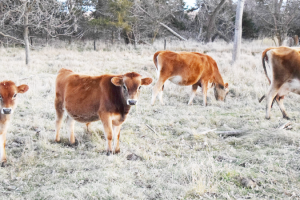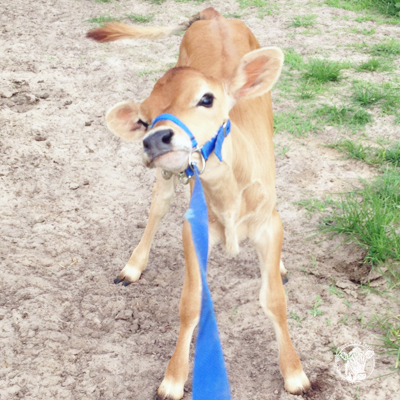This post may contain affiliate links. I may earn an affiliate commission if you click on a link and purchase an item at no additional cost to you. All opinions are my own.

Milk Fever and Your Family Cow
An Expensive Belly Ache
Right after my sweet Mabel had her twins, we had a little scare. A week after she calved, I went out to feed her. She was laying down, anxious, and when she did get up she kicked at her belly. Something was wrong and I feared it was Milk Fever, which can kill a cow within hours. The vet got there about 45 min later (how long it takes to get here from town!).
(Before I go on, be sure to follow me on Pinterest and Instagram!)
He listened for bowel tones, listened to her lungs and heart, watched her behavior and came to the conclusion that she just had a belly ache. He said it wouldn’t hurt to give her a calcium bolus (more about that later) just to be on the safe side and give her calcium a boost.
We were so relieved that it turned out she just had a belly ache (an expensive one at that!) from me increasing her feed too quickly. I was so thankful it wasn’t Milk Fever. We had dodged that bullet, but just a few months later, my neighbor lost her Jersey to what they figure was Milk Fever, so I’m prepared for next time and want you to be too.
What is Milk Fever?
Milk Fever (Hypocalcemia) is a metabolic disease that occurs within hours of calving caused by a low blood calcium level. When a cow’s calcium reservoirs are low the stress on the body from calving and production of milk/colostrum can be fatal.
We calve out around 600 Angus cows a year, and Milk Fever is not a problem with them. Dairy cows tend to be more prone to it because of the increased demand on their bodies. Right before a cow calves, her body gives calcium to the calf and then right after calving even more calcium goes into the colostrum and milk. Her calcium levels drop very quickly and if she didn’t have enough in store she likely will get Milk Fever.
Symptoms of Milk Fever
A cow that has Milk Fever will tend to be dull and listless, not anxious, like Mabel was. They will get weak. Once a cow goes down, they progress very rapidly. There are three stages to Milk Fever.
Stage I Milk Fever
This stage is very short, often lasting less than an hour, so it’s easy to miss. The symptoms typically are loss of appetite, weakness and overall discomfort.
Stage II Milk Fever
This stage can last from 1-12 hours. This is where you will see that dull look in her eyes, body temperature drops to 96-100 degrees (ears will be cold), trembling and lack of coordination. She also will not have bowel tones. Mabel had very loud bowel tones, so that gave the Vet a clue that it wasn’t Milk Fever.
Stage III Milk Fever
This stage is one I hope I never witness. She may go down and become unconscious. Once in this stage, she won’t last more than a few hours.
Milk Fever progresses very rapidly, but it can be avoided if you take the right precautionary steps.
Be Prepared
Our family milk cows become such a big part of our families and hearts, it’s best to be prepared for any emergency.
Mabel’s previous owner, a 4th generation Jersey dairy farmer, had told me to watch her closely right after she gave birth. Just to be safe, he suggested giving her a bolus called Bovikalc. I’d never had trouble when Gigi (read more about Gigi here) freshened, but since Jerseys and Guernseys are more prone to Milk Fever better to be safe than sorry.
Bovikalc is calcium bolus (aka giant cow pill) that you give prior to or immediately after calving and then again 12 hours later. You will also need a Balling Gun to get it down their throat. This bolus is a special size, so if you already have one it might not work! If you don’t have it already, print off my free First-Aid for Livestock checklist so you are always prepared!
From now on, even though we haven’t actually had this disease, I will administer Bovikalc just to ensure the health of my precious Jersey girl.
I hope you found this information helpful and will take the steps for keeping your family cow safe and healthy. As always, don’t hesitate to call your vet. A vet bill is a minor thing compared to losing a precious familycow. Don’t forget to grab your free printable first-aid for livestock checklist!
Until next time…
Happy Trails!
Tiffany

 Calf Sharing – Milk Once A Day!
Calf Sharing – Milk Once A Day! Your Guide to Buying a Family Milk Cow
Your Guide to Buying a Family Milk Cow Halter Breaking A Cow (And Calf)
Halter Breaking A Cow (And Calf) DIY Chicken Coop Project – Part 1
DIY Chicken Coop Project – Part 1